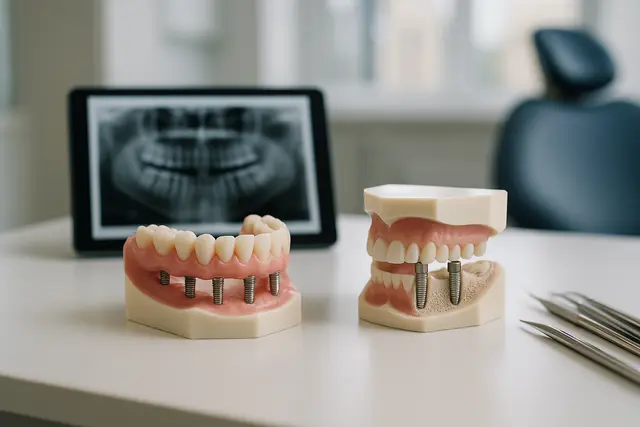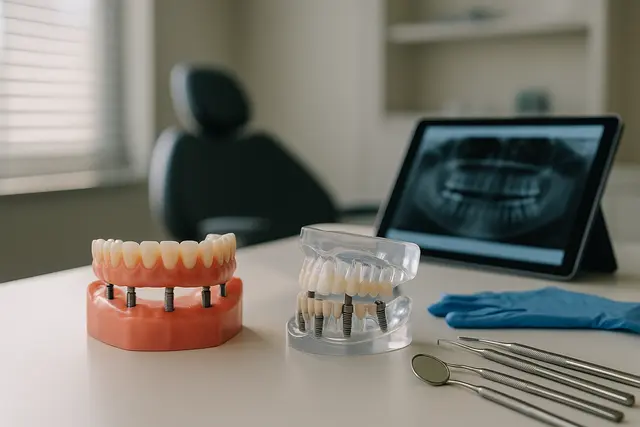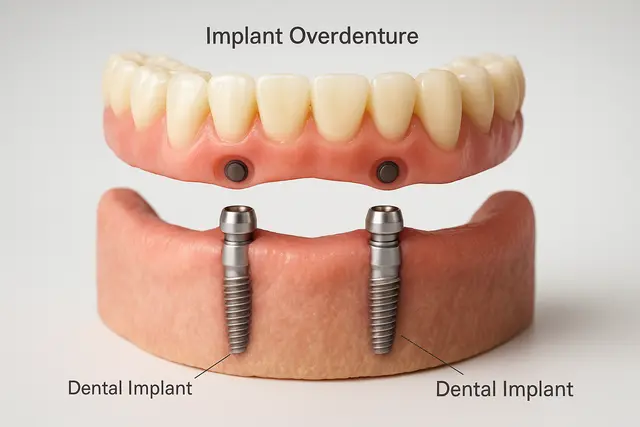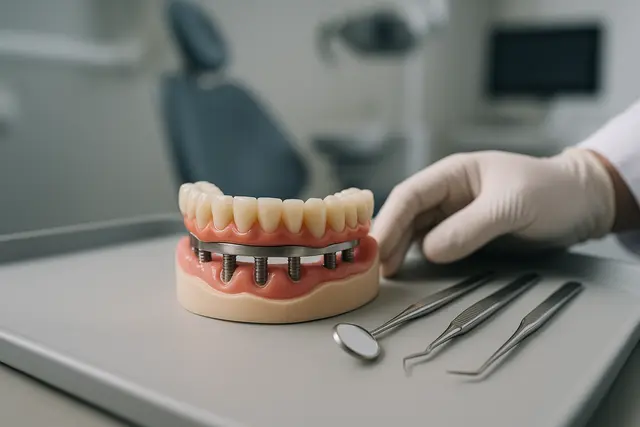Prosthodontics
4 min read
Oct 28, 2025
Implant Retained Dentures Explained
Considering implant-retained dentures? You're not alone. As modern dentistry evolves, more people are turning to this secure, natural-feeling alternative to traditional dentures. This guide will walk you through what they are, how they work, and why they might be the solution you've been looking for.

If the idea of wearing dentures gives you flashbacks to your grandpa’s teeth clinking in a glass, we’ve got news: things have changed. Today’s solutions are sleeker, smarter, and much more secure. Enter the implant-retained denture. It’s the high-tech cousin of traditional dentures, offering a stable, long-term fix that doesn’t slip when you laugh, chew, or chat over coffee.
Why Traditional Dentures Aren’t Always the Best Fit
Dentures typically help people smile, speak, and eat again after losing teeth. Traditional dentures rest on your gum tissue and rely on suction, or denture glue, to stay put. That works for some folks, but for many, it leads to problems like slipping, sore spots, or that constant fear they’ll fly out mid-meal. Not ideal.
Implant-retained dentures, on the other hand, are in a league of their own. They offer a level of stability and comfort that traditional dentures just can’t match. Think of them like your trusty hiking boots versus a pair of flip-flops on a rocky trail.
What Is an Implant-Retained Denture?
An implant-retained denture is a type of denture that’s securely anchored to your jaw using dental implants. These implants are small titanium posts that are surgically placed into your jawbone. Once healed, they act as rock-solid roots to hold your dentures in place. No more slipping. No more clicking. Just confidence.
You might hear them called implant-supported or implant-retained dentures, same idea. Instead of floating around your mouth, your dentures attach to implants for better support, better bite, and a big boost to your oral health.
How Implant-Retained Dentures Work
Here’s where it gets cool. After your initial consultation, your dentist will take x-rays to check for sufficient bone to support implants. If you’re good to go, the treatment involves placing four to six implants in your upper or lower jaw (or both), depending on your needs. In some cases, two implants can work for a lower jaw.
These implants are placed strategically, sometimes even at a 45-degree angle, to get the best grip from your jawbone. If your bone’s a bit shy, a bone graft might be recommended to bulk things up.
After healing (which takes a few months), abutments are added. These little connectors stick up from the gum and allow the dentures to snap or clip into place. This setup gives you the kind of stability that lets you chew steak, corn on the cob, or whatever you’ve been avoiding.
Why Dental Implant Solutions Feel Like Natural Teeth
Dental implants are a game-changer because they integrate with the bone in your jaw, mimicking the roots of natural teeth. They preserve the bone, which helps keep your face’s shape and avoids that sunken-in look people get from bone loss. Plus, they let your new smile feel strong, comfortable, and like it’s truly part of you.
And because they’re titanium, the body tends to welcome them without much fuss. They don’t slip, don’t wobble, and they make everyday life easier.
The Traditional Dentures Struggle Is Real
We’re not here to knock traditional dentures, they’re still a valid option for many. But the truth is, they rely on your gum tissue for support. That often leads to sore spots, irritation, and a chewing power that’s, well, less than stellar. Over time, bone loss from missing teeth can make it even harder to keep those dentures in place.
Implant-retained dentures solve those problems. They stimulate the jawbone, preventing the slow shrinkage that happens when teeth are missing. That means better oral health and fewer adjustments or relines down the line.
From Temporary Denture to Permanent Denture
Right after your implants are placed, you might wear a temporary denture while things heal. Once your implants are ready, your permanent denture will be custom made to fit the curve of your jaw perfectly. Your dentist will take an impression, design your prosthetic, and ensure everything clicks into place comfortably.
The final result? A natural-looking smile that stays put, lets you chew confidently, and feels like it’s always been yours.
The Implant Dentistry Process
The full process usually goes something like this:
Initial consultation and medical history review
Take x-rays and evaluate bone
Possible bone graft if needed
Placing four dental implants (or two to six, depending on your case)
Healing and integration of implants into the bone
Add abutments
Attach the dentures to the implants
Final adjustment and fit
Your dentist will go over sedation options if you’re feeling a bit nervous, and create a treatment plan tailored just for you.
Caring for Your Implant-Retained Denture
Just because they’re not natural teeth doesn’t mean you can slack on dental care. Cleaning and maintenance are key. You’ll still need to brush your gums, clean around the implants, and visit your dental professional regularly.
Some implant-retained dentures are removable for easy cleaning, while others stay in place. Your dentist will walk you through the pros and cons of each style.
Are You a Candidate for Implant Dentistry?
If you’re tired of traditional dentures, want to replace missing teeth with something more secure, and have enough bone to support implants, this might be your dream solution.
Even if you’re not sure, a consultation with a skilled dentist can clear things up. They’ll review your medical history, take a close look at your jaw, and go over all your treatment options. Most patients are surprised to learn just how many options are available.
What Are Implant-Retained Dentures?
Implant-retained dentures are dentures that are anchored securely to your jaw using dental implants, small titanium posts that act like artificial tooth roots. Unlike traditional dentures that rest on the gums, these dentures clip or snap into place, offering greater stability, comfort, and bite strength. They’re ideal for people seeking a more natural-feeling, secure tooth replacement.
How Do Implant-Retained Dentures Stay In Place?
These dentures stay in place by attaching to two to six dental implants surgically placed in your jawbone. Once the implants heal and fuse with your bone (a process called osseointegration), abutments are attached to the implants. Your custom-made denture then clips or snaps onto those abutments, offering a strong, no-slip solution that can handle everyday eating and speaking.
What’s the Difference Between Implant-Retained and Traditional Dentures?
Traditional dentures rest on the gums and rely on suction or adhesives, which can lead to slipping, sore spots, and lower bite strength. Implant-retained dentures, by contrast, are stabilized by dental implants, offering superior security and comfort. They also help prevent bone loss in the jaw, which is a common issue with long-term use of traditional dentures.
Who Is a Good Candidate for Implant-Retained Dentures?
Good candidates are those who have lost multiple teeth and want a stable, long-term solution. You’ll need enough healthy jawbone to support the implants, though bone grafting can be an option if volume is low. A consultation with your dentist will include X-rays and a medical review to ensure you’re a good fit for this life-changing dental option.
Read Next
Related Posts

Prosthodontics
Implant Supported Dentures Overview
Missing teeth can impact more than just your smile, they can affect your confidence, comfort, and even your diet. Fortunately, modern dentistry offers a solution that’s both secure and natural-looking: implant-supported dentures. This innovative approach blends the stability of implants with the convenience of dentures to create a long-lasting, life-improving upgrade.
5 min read
Oct 29, 2025

Prosthodontics
Implant Overdentures Explained: The Hybrid Solution to Missing Teeth
Missing teeth can impact everything from your ability to eat to your self-confidence. While traditional dentures have long been a go-to solution, they often fall short in comfort and stability. Implant overdentures offer a modern alternative that combines the security of dental implants with the convenience of removable dentures, a true upgrade for those looking to reclaim their smile.
6 min read
Oct 29, 2025

Prosthodontics
Hybrid Dentures Overview: The Perfect Blend of Comfort and Stability
Finding the right tooth replacement option can be overwhelming, especially if you’ve struggled with discomfort, instability, or endless denture adhesive. Hybrid dentures offer a modern solution that blends the best features of traditional dentures and dental implants, delivering both comfort and confidence.
5 min read
Oct 28, 2025
Don’t have time to research every dentist around you?
See why 30k+ patients trusted us